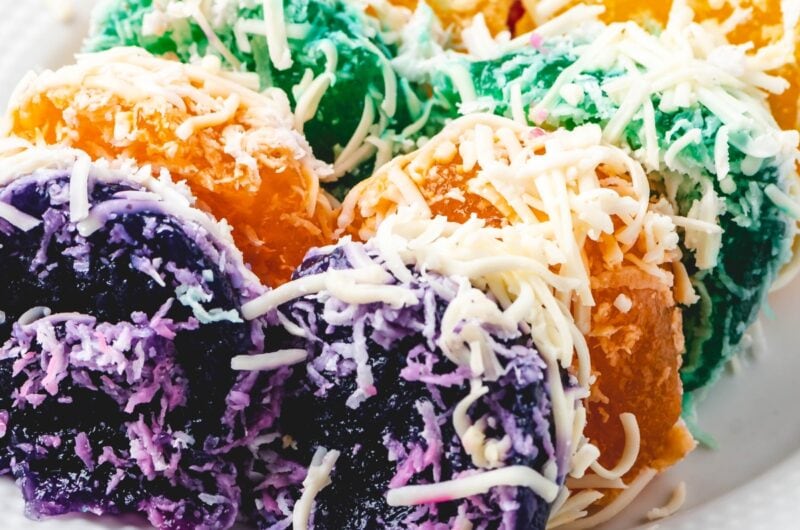These decadent Filipino cakes are like nothing you’ve ever tried before. If you’re into sticky rice and flan, you’re in for a treat.
Filipinos take ingredients like rice, coconut, cassava, and purple yam and turn them into magical sweets. Seriously, these aren’t your run-of-the-mill chocolate or vanilla treats.

Leche flan will satisfy that creamy fix, while ube cake will delight you with its vibrant purple hue. And if you’re curious about rice cakes, there’s an assortment of them here, too.
Get ready to fall for Filipino cakes, one bite at a time. Let’s go!
1. Ube Cake (Filipino Purple Yam Cake)
Purple yam is common in the Philippines, and it shines as ube, an ultra-rich jam-like treat.
This creamy ube isn’t just for eating on its own, though. It’s a key ingredient in many Filipino desserts. In this case, ube jam makes the most decadent cake.
The sponge cake layers are infused with ube, and the buttercream filling is loaded with it.
2. Bibingka (Filipino Coconut Milk Cake)
Christmas in the Philippines means bibingka. The scent fills the air around churches during night mass, tempting passersby.
It’s a thick, fluffy hot cake that gets its unique texture from rice flour. Coconut milk adds a sweet richness that sets it apart.
Melted butter, shredded cheese, toasted coconut, and salted egg slices create a perfect mix of sweet and salty.
3. Taisan (Filipino Chiffon Cake)
Taisan is the no-frills, all-flavor cake you didn’t know you needed.
Think of it as the Filipino cousin of the chiffon cake, but baked in a loaf pan.
After baking, it gets a buttery makeover. Melted butter is brushed all over the top, and then comes the sugar and shredded cheese.
Each slice delivers a rush of sweetness and a cheesy kick.
4. Filipino Cassava Cake with Macapuno
Cassava cake is a popular Filipino delicacy made of grated cassava, coconut milk, condensed milk, and macapuno.
The cassava makes the cake soft, sticky, and chewy, kind of like a firmer, less gooey mochi.
Macapuno is a special kind of coconut meat that’s soft and almost jelly-like. It adds a whole new layer of chewiness to the cake.
5. Kutsinta
Kutsinta is a snack in the Philippines eaten any time of day. Street vendors carry big cans of it and sell it like hotcakes.
It’s a steamed cake made of flour, tapioca flour, and brown sugar. The result is something soft but chewy, almost like a firmer version of mochi.
The grated coconut on top adds a tropical twist that pairs well with the brown sugar.
6. Sans Rival
The first time I tasted sans rival, I was blown away.
The name says it all: sans rival, or ‘without rival,’ and it truly lives up to that.
It’s inspired by the French Dacquoise but with a local twist. Instead of almonds or hazelnuts, it uses cashews.
There are layers of nutty meringue filled with rich French buttercream sprinkled with crunchy cashews on top.
7. Pichi Pichi
This phenomenal Filipino cake calls for three ingredients: cassava, water, and sugar. That’s it!
The mix gets steamed and turns into something you won’t forget: a sweet, glutinous cake that’s irresistibly chewy.
Now, here’s where it gets even better. After it cools down, you roll these little gems in either grated coconut or grated cheese.
8. Puto (Filipino Steamed Rice Cakes)
If you’ve ever been to a Filipino party, chances are you’ve already come across these colorful bite-sized cakes.
Soft, chewy, and just the right amount of sweetness, these cakes are comfort food in a tiny package.
The name puto has its roots in the Malay word “puttu,” meaning “portioned.”
They’re the perfect one-bite wonders!
9. Leche Flan
Smooth, creamy, and oh-so-sweet, flan is one of the most popular Filipino desserts.
The basics for leche flan are the same as any other: milk, egg yolks, and sugar. What sets it apart is how it’s used in the Philippines.
It’s not just a standalone treat, it’s a team player.
10. Biko (Filipino Sticky Rice Cake)
Biko is a sticky, chewy rice cake cooked with coconut milk and brown sugar. It gets even better with a topping of latik or sweet coconut curds.
In the Philippines, biko is often the star at special gatherings.
Whether it’s a birthday, a family reunion, or a town fiesta, it’s always present.
It’s traditional, delicious, and something you have to try.











